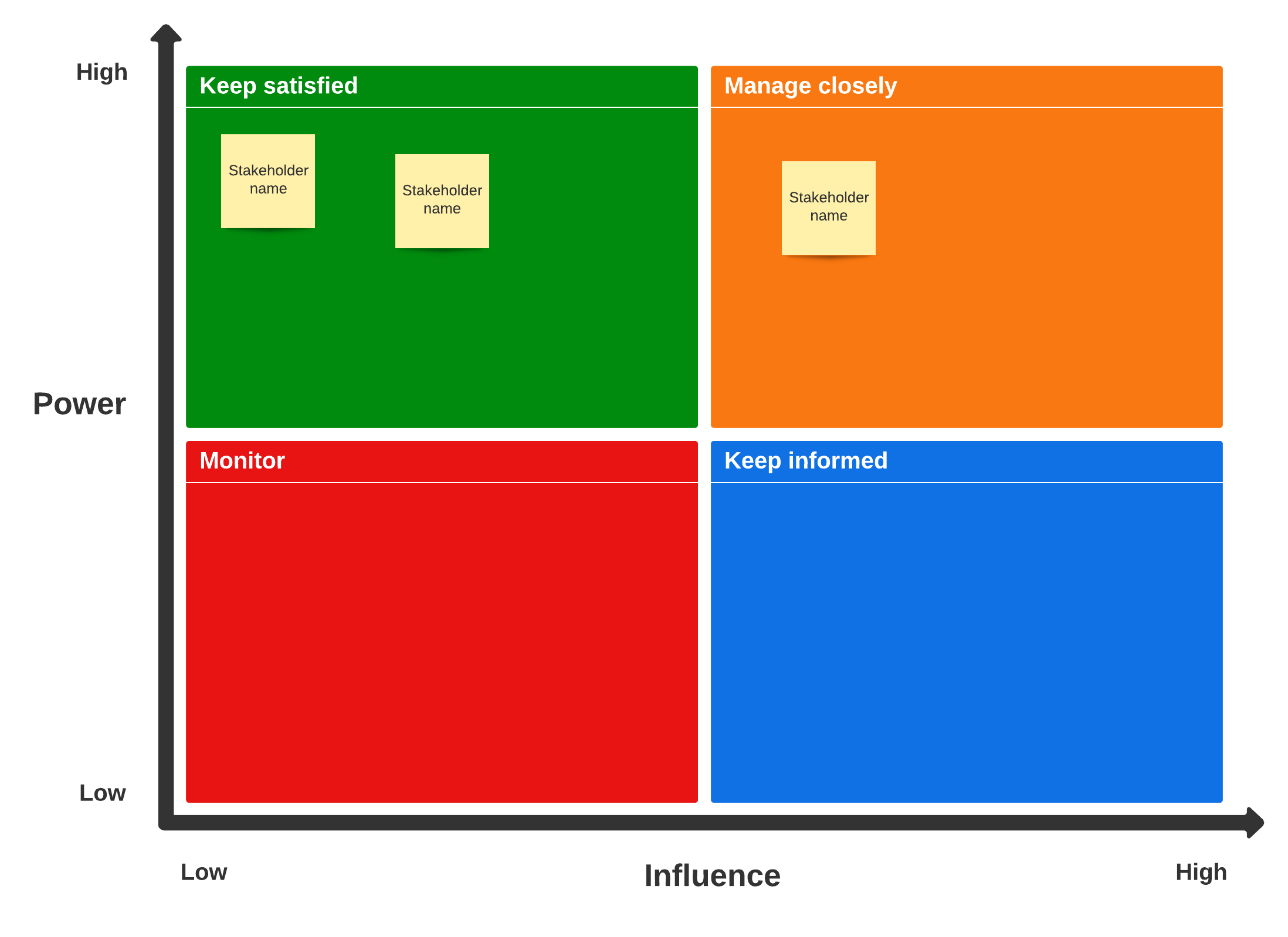In the business world, projects aren’t completed in a vacuum. In order to get new initiatives or projects off the ground, you need buy-in and support from a variety of people like managers, executives, and clients. These people are your stakeholders.
Stakeholders can make or break your project before it even starts, so it’s crucial to understand who your stakeholders are, what level of input they have, and the communication they will need throughout the project so you can keep them on board from day one to done.
But how do you know who your stakeholders are? And how do you keep them engaged? When working on large or complex projects, it can be difficult to keep track of all the relevant stakeholders involved.
That’s where stakeholder analysis and stakeholder mapping come in. Use our quick and dirty guide to chart your course from start to finish.
What is stakeholder mapping?
Maps tell us the lay of the land and can reveal our options for getting from Point A to Point B. When it comes to project management, stakeholder mapping uncovers and visualizes your project’s environment and the stakeholder ecosystem you’re working in—including potential hazards or roadblocks you’ll need to navigate. Once you know those, you can chart your project with greater confidence, working more effectively with stakeholders at every level.
Start with a stakeholder analysis
Before you jump into stakeholder mapping, you first need to conduct an analysis.
The purpose of stakeholder analysis and mapping is to:
- Enlist key players early on
- Align stakeholders on project goals and plans
- Uncover and address conflicts or concerns
A stakeholder analysis helps you identify your stakeholders and prioritize them based on interest, influence, and financial investment (among other relevant factors). Once you understand who your stakeholders are, what they need, and how they impact your project, you can make better decisions, communicate effectively, and secure the buy-in you need.
With that info in hand, you can then visualize your findings in an organized stakeholder map.
Chart your course
A stakeholder map is a visualization (or roadmap) of your completed stakeholder analysis. A stakeholder mapping tool helps you organize your analysis into a clear, digestible visual format and outline a plan of action for communication and engagement with your stakeholders. Stakeholder maps can be outlined in a simple grid, spreadsheet, or digital whiteboard like Lucidspark.
So when should you use a stakeholder map?
Stakeholder maps are helpful for any project, but especially when you have a large project that impacts lots of key players across roles, departments, and even organizations. Particularly at this scale, projects require clear and polished communication to ensure successful management, streamlined processes, and enthusiastic buy-in.
In other words, use a map when you have a big journey ahead of you. It’s easy to get lost when you have too many stakeholders to juggle. And you don’t want to find yourself up a creek mid-project without a paddle.
Why is stakeholder mapping important?
If you’re still not sure why stakeholder maps are crucial, think of it this way: Stakeholder maps help you successfully identify and manage your stakeholders. Sure, you could wing it, but success is more likely when you have a clear plan of action.
Stakeholder mapping and analysis help you:
- Engage key stakeholders early on to gather critical input and support to get your project off the ground.
- Secure needed resources, giving you the momentum you need to move the project forward.
- Improve communication throughout the project so you can build understanding among stakeholders, align them with your goals and plans, and maintain support throughout.
- Anticipate stakeholder questions, concerns, and needs so you can craft more effective messaging and make decisions that are more likely to keep your stakeholders happy.
The better you understand your stakeholders, the better you can communicate with them and secure their support. Use stakeholder maps to guide you.
How to perform a stakeholder analysis
There are 3 main steps of a stakeholder analysis:
1. Identify potential stakeholders
The first step is brainstorming who your stakeholders are. Keep in mind that stakeholders can be internal (e.g., your company’s top leadership, team members and department supervisors, etc.) or external, such as your client and their extended team as well as potential end-users.
As you evaluate possible stakeholders, consider:
- Who has the most influence on this project?
- Who will be most impacted by this project?
- Who controls the resources I need?
- Who has financial stake or interest?
- Who might be an important person but not a central stakeholder (such as a separate department leader)?
By the end of this exercise, you should have a solid list of players to evaluate.
2. Prioritize stakeholders
Once you have your list of stakeholders, it’s time to prioritize them based on their relative importance and influence on your project. In other words, some stakeholders will have more say in how the project evolves and what resources are made available than others. It’s important to uncover who these key players are so you can effectively communicate with them and create buy-in throughout the project.
This is a good time to use a stakeholder matrix to organize your players. By organizing each stakeholder according to their influence and interest, you can determine what action(s) you need to take, including:
- Keep satisfied (high power, low interest)
- Manage closely (high power, high interest)
- Inform regularly (low power, high interest)
- Monitor and anticipate needs (low power, low interest)

For example, a stakeholder with high influence but little interest won’t need as much information or engagement as a stakeholder with high influence and high interest.
The more power and interest a stakeholder has, the more attention they will need to stay informed and engaged. If you fail to keep these stakeholders satisfied, you could endanger your project if they choose not to approve key funding or other resources.
3. Create a plan for engaging with stakeholders
Armed with this information, you can now create a plan for engaging with stakeholders throughout the life of your project.
You’ll want to consider factors like:
- Who has an emotional interest?
- What are the top motivations or priorities for each stakeholder?
- Who are the biggest supporters or sympathizers?
- Who are the blockers or naysayers?
These answers to these questions will affect how and when you should engage with each stakeholder and help you identify your biggest allies and anticipate potential roadblocks.
Use your stakeholder map to chart where different players align on your power grid and make note of their individual motivations, priorities, and level of support. Be sure to note which people have existing connections so you can uncover and map out who might be able to persuade less-enthusiastic stakeholders.
Map stakeholders with the right tools
Using the right tools for the job can make a world of difference in the quality and efficiency of your work. While you can manually analyze and map your stakeholders, this can be a tedious and time-consuming effort—particularly for larger, more complex projects.
Lucidspark makes stakeholder mapping easy with ready-made templates to get you started.
Organize your stakeholder info by adding virtual sticky notes and comments directly to the whiteboard, use color-coding so you can quickly understand the big picture, and loop in team members with easy sharing and @mentions for collaboration. Take advantage of Lucidspark’s infinite canvas to add custom flowcharts and decision timelines so you can easily manage your stakeholders and keep everyone aligned from start to finish.

Get a jumpstart on your own stakeholder map today using our helpful template.
Get startedAbout Lucidspark
Lucidspark, a cloud-based virtual whiteboard, is a core component of Lucid Software's Visual Collaboration Suite. This cutting-edge digital canvas brings teams together to brainstorm, collaborate, and consolidate collective thinking into actionable next steps—all in real time. Lucid is proud to serve top businesses around the world, including customers such as Google, GE, and NBC Universal, and 99% of the Fortune 500. Lucid partners with industry leaders, including Google, Atlassian, and Microsoft. Since its founding, Lucid has received numerous awards for its products, business, and workplace culture. For more information, visit lucidspark.com.
Related articles
2 templates to help with stakeholder management
In this blog post, we will explain the importance of effective stakeholder management, as well as share a few templates to get you started.
How to create a customer journey map
Learn how to create a customer journey map to understand and optimize your customers’ journeys with your brand so that they want to make a return trip and tell all their friends about their experience.

